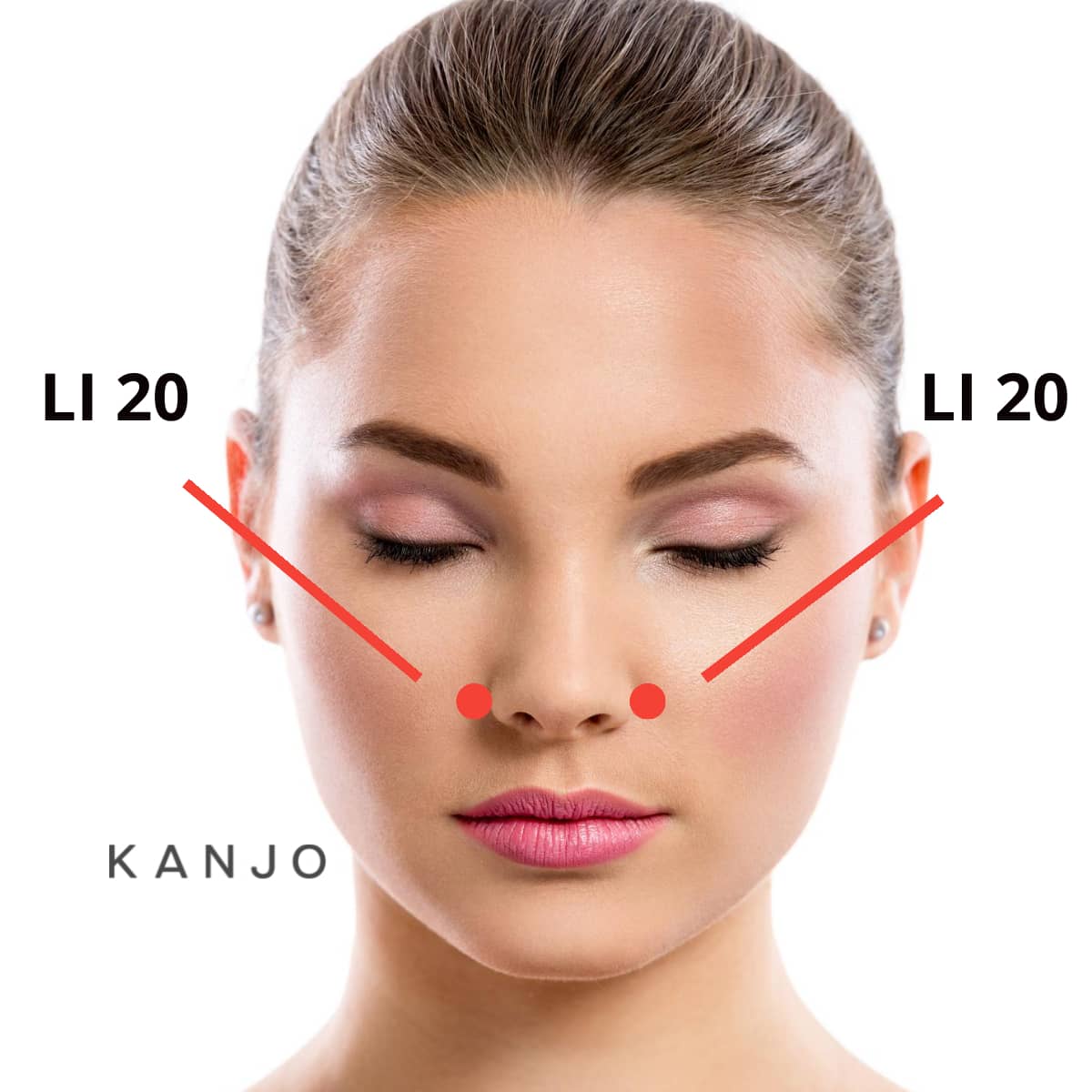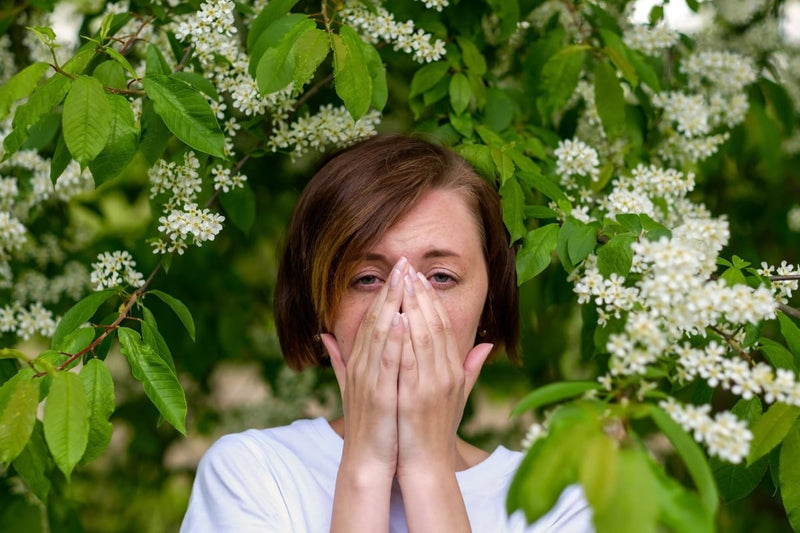Do you get allergies every allergy season or even throughout the year?
There are many reasons why we get allergies. Some people just have a genetic predisposition to allergies, while others develop allergies due to environmental factors, such as pollen, air pollution, etc.
Claritin and other antihistamines can help relieve some of your symptoms, but there are also many natural remedies that you can use to help alleviate your symptoms. One of them is acupressure.
This article will cover the main pressure points for allergies that are a natural remedy to try at home, and how to apply them yourself.

Can You Use Acupressure for Allergy Relief?
Acupressure therapy can help to prevent seasonal allergy symptoms and relieve symptoms as they happen. Allergy symptoms from itchy eyes, runny nose, and sinus headaches can all be relieved by stimulating the right pressure points.
Acupressure is a Traditional Chinese Medicine (TCM) that uses pressure on specific points of your body to relieve pain, stress, and other ailments. It can also help with other health issues, including allergy relief.
Acupressure works by stimulating acupuncture points. These points are located all over the body, but they tend to be more concentrated around the head, neck, back, shoulders, stomach, arms, legs, and feet.
Here are the Pressure Points to Help With Allergies
Stimulating these acupressure points will help to relieve symptoms of your allergies.
1. Spleen 5 (SP 5) - Shangqiu or Shang Mound

The SP 5 pressure point is located on the inside of the ankle, just by the protruding bone. It's in a depression distal, that's inferior to the medial malleolus midway, and between the tuberosity of the navicular bone and the tip of the medial malleolus.
Stimulating this point will help with allergy relief. The pressure point will also help to relieve foot and ankle pain, hemorrhoids, and digestive issues. The Shangqiu point can relieve gastrointestinal intestinal conditions like constipation, diarrhea, and abdominal distention and pain.
2. Large Intestine 20 (LI 20) - Yingxiang or Welcome Fragrance

The LI 20 point is easily accessible on the outside of both nostrils, just to the side.
Applying firm pressure to these points will open up nasal passages to relieve nasal congestion. It will also help with sinus issues, nasal polyps, rhinitis, and sinusitis.
3. Stomach 2 (ST 2) - Sibai or Four Whites

The ST 2 pressure point is found directly below the eyes on your cheek bones.
Stimulation of the pressure points will help to relieve allergy symptoms in the eyes. It can help relieve red, itchy, and painful eyes, eyelid twitching, excess lacrimation, and sinus pressure.
4. Bladder 2 (B 2) - Cuanzhu or Bamboo Gathering

The B 2 acupressure point is located on the inside end of the eyebrows by the center of the forehead.
Pressure and massage on these points will help to relieve red, watery, and itchy eyes from allergies. You'll also get relief from sinus pressure and congestion, and headaches.
How to Massage Your Pressure Points
Applying firm pressure and gently massaging the pressure points above will offer relief from allergy symptoms. You can repeat the pressure and massage a few times throughout the day as needed.
Follow these steps for the points below:
- Use your thumb or 1-2 fingers on each pressure point. The most frequently used fingers are the index and middle fingers (2nd and 3rd fingers) because they give you the most leverage when pressing.
- Apply pressure for 5 seconds. Slowly take deep breaths while pressing and holding.
- Gently massage the acupressure point in a circular motion for 2 minutes at the point.
- For each pressure point, repeat the pressure and massage cycle 5 times.
When to See a Doctor
If you're experiencing severe allergy symptoms, see a doctor right away. If you don't feel better after trying acupressure, then you should seek medical attention.
Acupressure is safe and effective if performed correctly. If done incorrectly, however, it could cause injury. If you feel more pain than relief, discontinue acupressure immediately.
Always consult your physician if you are pregnant, have other health conditions, or taking prescription medications.

Pressure Points for Allergies FAQs
Where Do You Feel Pressure from Allergies?
Allergies will most often cause pressure in the sinuses, nose, throat, and eyes. The pressure in those areas can lead to headaches, runny noses, sneezing, sore throats, coughing, and wheezing. You can use acupressure to relieve some of the common allergy symptoms.
What Makes Allergies Worse at Night?
Allergies tend to worsen at night because the weather is cooler, which pushes down the pollen from trees and plants in the air. That will cause pollen to stick to your clothes, hair, and bedsheets. Warm temperatures will allow pollen to float in the air, which makes it easier for the allergens to be blown away.
Are Air Purifiers Good for Allergies?
Air purifiers are good for filtering and removing allergens, dust, pollen, and pet dander from the air. They won't remove all allergens, but they can help reduce the amount that's floating around. Tiny particles that aggravate allergies will often settle on your floors, furniture, and walls, and when disturbed, they will be released into the air. A good air purifier will help to filter those allergens out.
Sources:
- Cleveland Clinic: https://health.clevelandclinic.org/try-this-easy-6-minute-acupressure-exercise-for-allergy-relief-video/
- Clayton Chiropractic: https://claytonchiropracticstl.com/acupressure-for-seasonal-allergies/
- Huffington Post: https://www.huffpost.com/entry/acupuncture_b_1407077
